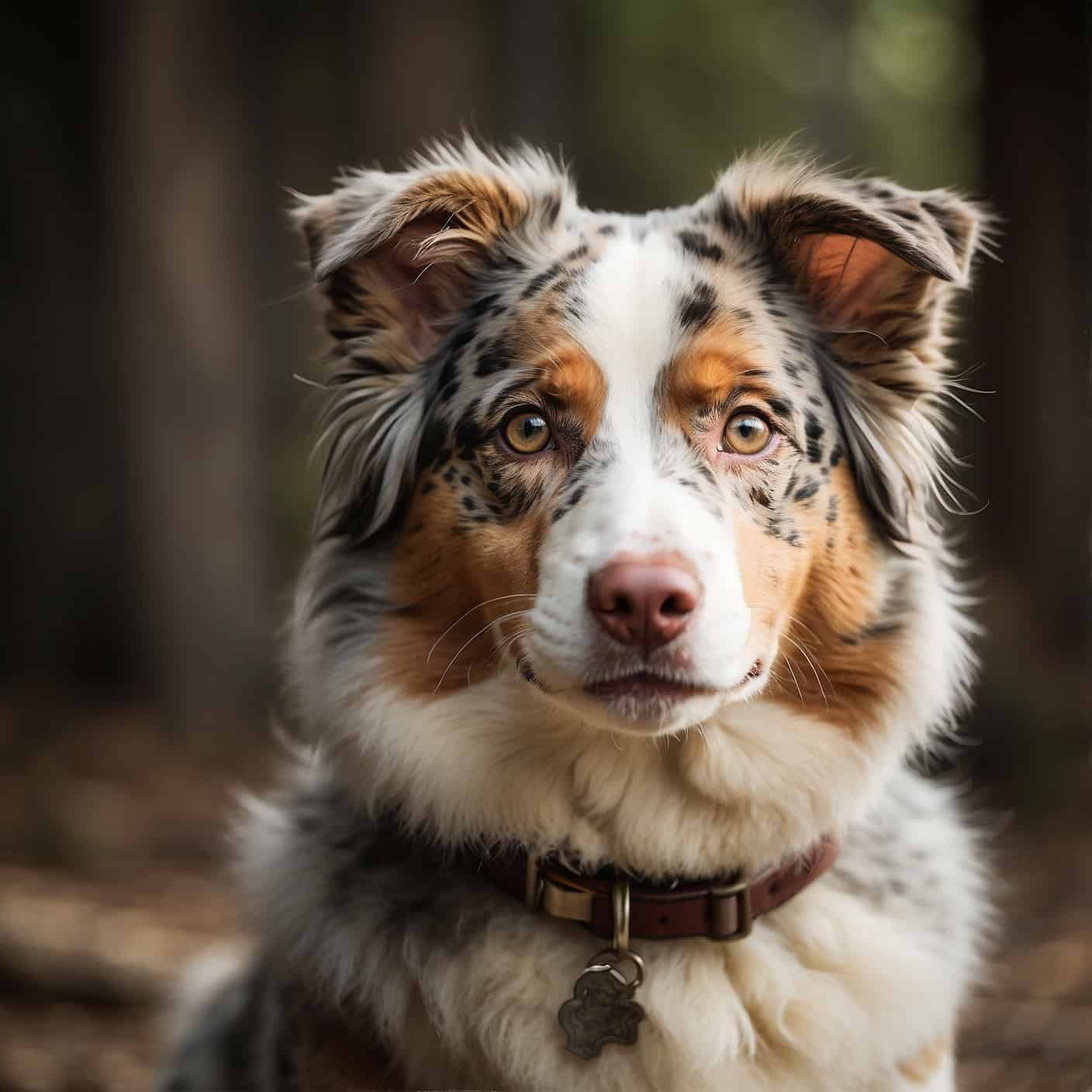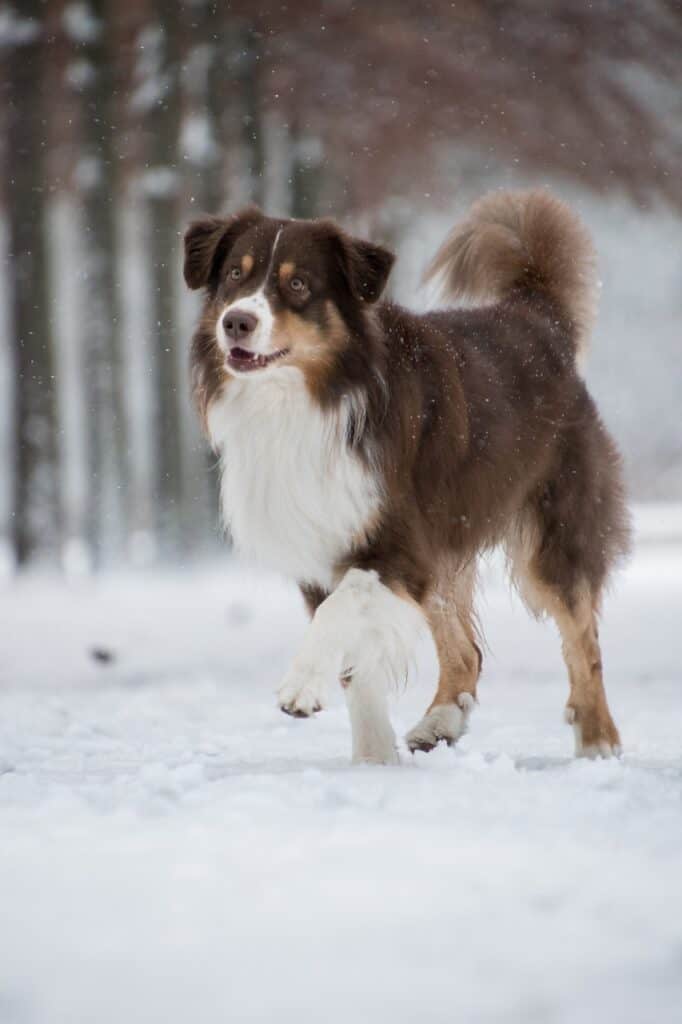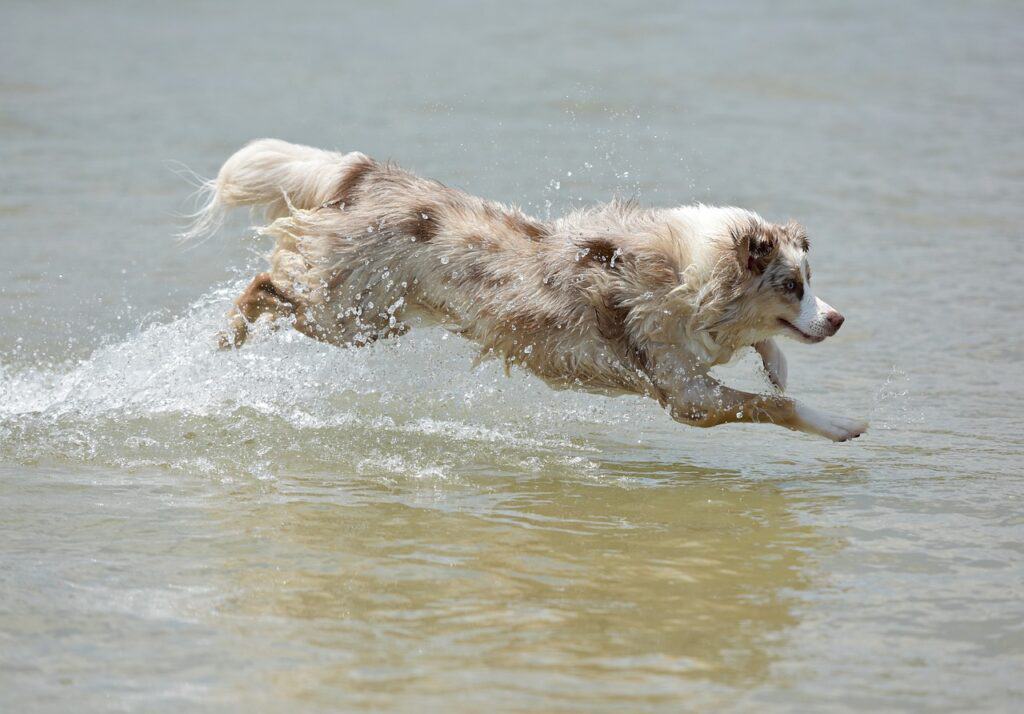The Australian Shepherd, a symbol of boundless energy, remarkable agility, and unwavering loyalty, has captured the hearts of dog enthusiasts and active individuals alike. With its origins in the American West, striking appearance, and a unique set of personality traits, this breed has solidified its reputation as an esteemed companion and a remarkable herding and working dog.

| Category (Explanation) | Breed Information |
|---|---|
| Year of Breed Conception | 19th century |
| Country of Origin | United States (despite the name) |
| Weight (lbs & kg) (Male) | 50-65 lbs (23-29.5 kg) |
| Weight (lbs & kg) (Female) | 40-55 lbs (18-25 kg) |
| Coat Type | Medium-length double coat |
| Color Variations | Various colors, including blue merle, red merle, black, and red |
| Shedding Level (Low, Moderate, High) | Moderate |
| Height (cm & in) | 18-23 inches (46-58 cm) |
| Breed Size | Medium |
| Trainability (Low, Moderate, High) | High |
| Mental Needs (Low, Moderate, High) | High |
| Intelligence Level (Low, Moderate, High) | High |
| Energy Level (Low, Moderate, High) | High |
| Agility (Low, Moderate, High) | High |
| Loyalty (Low, Moderate, High) | High |
| Playfulness (Low, Moderate, High) | High |
| Exercise Needs | Regular, vigorous exercise and mental stimulation |
| Guarding Proficiency (Low, Moderate, High) | Moderate |
| Sociability with Children (Low, Moderate, High) | High |
| Barking Level (Low, Moderate, High) | Moderate |
| Digging Tendency (Low, Moderate, High) | Moderate |
| Destructive Behavior (Low, Moderate, High) | Moderate |
| Drooling Level (Low, Moderate, High) | Low |
| Obedience Level (Low, Moderate, High) | High |
| Apartment Friendly (Yes/No) | Can adapt to apartment living, with sufficient exercise |
| Inherent Prey Drive | Moderate |
| Physical Risk to Others (Low, Moderate, High) | Low |
| Travel Fatality Risk (Low, Moderate, High) | Low |
| Allergen Potential | Low |
| Health Concerns (List of Common Health Concerns) | Hip Dysplasia, Eye Issues, Epilepsy, Collie Eye Anomaly |
| Average Life Expectancy (Life Expectancy in Years) | 12-15 years |
Woof Mastery is reader supported and our articles may contain affiliate links.
Instead of running third party ads that we have no control of we only use links from high-quality companies we are directly partnered with. Making use of these links come at no cost to you our reader, and in many cases have the extra benefit of discounted rates or sign up bonuses.
If you’re interested you can read more about our affiliate policy here.
We appreciate your support and always insure that the products and services we recommend are high-quality, helpful and relevant to the subject at hand!
The Australian Shepherd, despite its name, has a history closely tied to the American West. These dogs originated in the 19th century as herding dogs in the western United States, where they were known for their agility and intelligence.
The breed’s history includes Basque shepherds who brought their dogs to the American West, where their herding skills were put to use on ranches. Their proficiency in herding cattle and other livestock earned them the nickname “Australian” due to the belief that the Basque shepherds hailed from Australia.
Today, Australian Shepherds are cherished for their herding abilities, intelligence, and energetic nature. They have found a place in many hearts as beloved family pets and versatile working dogs.

What makes the Australian Shepherd special is its incredible work ethic and boundless energy. These dogs thrive on activity and excel in various dog sports, making them ideal companions for active families and individuals.
Their intelligence and trainability also set them apart, making them quick learners and highly responsive to commands. This, combined with their loving nature, makes them cherished family members and exceptional working dogs.
Australian Shepherds have a rich history as herding dogs in the American West, despite their name. They played a crucial role in herding and guarding livestock, especially in rugged and remote areas. Their agility and herding instincts made them indispensable in managing cattle and sheep. Today, they continue to excel in herding competitions and serve as active and affectionate family pets, embodying their legacy as reliable working dogs.
Australian Shepherds have remarkable and endearing personalities. They are known for their high energy, intelligence, and an insatiable desire to work and play. These dogs thrive on mental and physical challenges, making them excellent partners for active individuals and families.
Their intelligence and trainability set them apart as quick learners and eager participants in various activities. Despite their boundless energy, they have a sweet and loving nature, forming strong bonds with their human families and making them delightful and loyal companions.
Australian Shepherds are highly intelligent, energetic, and loyal. They have a strong herding instinct and may try to herd children or other pets. Their boundless energy requires mental and physical stimulation, such as agility training and play.
They are loving and protective of their families, making them excellent companions. Early socialization helps them get along well with other dogs and people.
Australian Shepherds are medium-sized dogs with a balanced and sturdy build. They have a slightly rounded head with expressive oval-shaped eyes. Ears are triangular and can be either erect or semi-erect.
They have a double coat with a medium-length, weather-resistant outer coat. The coat colors are diverse and include blue merle and red merle with marbled patterns, often accompanied by white markings. Their tail can be naturally bobbed or long and bushy.
Males typically stand between 20 to 23 inches (51-58 cm) at the shoulder and weigh between 50 to 65 pounds (23-29 kg), while females are slightly smaller and lighter.
Australian Shepherds have an alert and lively presence, reflecting their herding heritage and versatility.
Australian Shepherds exhibit various coat colors, including:
Australian Shepherds often have a merle coat pattern, which is marbled or mottled, and can come in blue merle or red merle variations. Some may have solid coat colors without merle patterns.
Australian Shepherds have a moderate shedding level. They shed throughout the year, with more pronounced shedding during seasonal changes. Regular brushing and grooming can help reduce shedding and keep their coat in good condition.
Australian Shepherds have a medium-length double coat that requires regular grooming. Grooming habits for this breed include:
1. Brushing: Regular brushing, at least once or twice a week, helps prevent matting and removes loose fur. Focus on their dense undercoat with an undercoat rake or slicker brush.
2. Bathing: Bathe Australian Shepherds when necessary, using a dog-specific shampoo and thorough rinsing.
3. Ears: Check and clean their ears regularly with a veterinarian-recommended solution to prevent wax buildup or infections.
4. Nails: Keep their nails trimmed to a comfortable length to maintain proper gait and prevent discomfort.
5. Teeth: Brush their teeth regularly to ensure dental health and prevent bad breath. Dental chews or toys can be helpful.
6. Tail and Paw Care: Maintain cleanliness in the tail and paw areas, inspecting for any signs of irritation or injury.
Australian Shepherds have a high activity level and thrive on both physical and mental challenges. Key points about their activity level include:
1. Exercise Needs: Australian Shepherds require daily exercise to stay happy and healthy. Activities can include long walks, runs, and interactive play.
2. Energy Level: They are known for their high energy levels, especially when young. Regular exercise is important to keep them content.
3. Herding Heritage: Historically, Australian Shepherds were bred for herding livestock. They excel in activities like herding trials, agility, and obedience.
4. Mental Stimulation: In addition to physical activity, mental stimulation through obedience training and puzzle toys is essential.
5. Outdoor Companions: They make great companions for those who enjoy outdoor activities like hiking, jogging, and dog sports.
Miniature American Shepherds are highly intelligent and eager to learn. Here are some key points about their intelligence:
Their high intelligence and agility make Miniature American Shepherds great companions and working dogs. Training and mental stimulation are essential for their well-being.
Australian Shepherds are highly intelligent and need mental challenges. Provide them with puzzle toys, agility training, and interactive tasks to keep their minds engaged.
Social Interaction: They are social dogs and require regular interaction with their human family. Loneliness can lead to anxiety or destructive behavior.
Exercise: Mental stimulation through training and problem-solving exercises is crucial to their well-being.
Training and Obedience: Australian Shepherds benefit from obedience training and advanced tricks, which provide mental stimulation and strengthen the bond with their owners.
Enter The Woof Mastery

Before choosing an Australian Shepherd, keep these considerations in mind:
1. Activity Requirements: Aussies are energetic and need plenty of physical and mental exercise. They thrive in active households.
2. Training Needs: These intelligent dogs require consistent training and socialization to prevent behavioral issues.
3. Space: Aussies need space to move, so a yard or access to open areas is ideal.
4. Coat Care: Their double coat requires regular grooming to manage shedding and matting.
5. Herding Instinct: Be prepared for their natural herding instincts, which may include nipping at ankles or herding family members.
Australian Shepherds, while not as large as some breeds, may pose a physical risk to others if not properly socialized, trained, or managed. The risk assessment factors include:
1. Protective Instinct: Australian Shepherds can have a protective instinct, especially toward their family. Proper training is necessary to manage this behavior.
2. Socialization: Early and thorough socialization is crucial to ensure Australian Shepherds are comfortable around people and other animals. Poor socialization can lead to fear or aggression.
3. Training: Obedience training is essential to teach Australian Shepherds appropriate behavior and ensure they respond to commands. Well-trained dogs are less likely to engage in aggressive behavior.
4. Owner Responsibility: Responsible ownership involves being aware of the dog’s behavior and taking necessary precautions in public settings.
5. Breed-Specific Legislation (BSL): Australian Shepherds may not be subject to BSL as frequently as larger breeds, but owners should be aware of local regulations.
6. Individual Variability: Each dog is unique, and behavior can vary. Responsible ownership, proper training, and socialization are key to minimizing the potential physical risk to others.
Australian Shepherds are usually good with kids. They are known for their herding instincts, which may lead to them trying to herd children. However, with proper training and socialization, they can be gentle and affectionate family pets. They are energetic and enjoy playtime with children.
Australian Shepherds are often good swimmers, thanks to their athleticism and endurance. Their physical build is advantageous for swimming, and many may exhibit a natural instinct for it. However, as with any breed, individual comfort levels with water can vary. Supervision is crucial when introducing them to swimming.
Positive training practices will help your Australian Shepherd puppy become a well-behaved and devoted companion.
Australian Shepherds are often rated as moderate to high in terms of noisiness. They have strong herding instincts and may bark or use other vocalizations to control and communicate with livestock. They can also be vocal when they are excited or anxious.
Australian Shepherds thrive in homes that provide:
Challenges:
Traveling with Australian Shepherds involves these considerations:
Australian Shepherds are generally healthy, but they may be prone to certain health concerns, including:
Proper nutrition is crucial for Australian Shepherds. Follow these nutritional habits:
Proper nutrition is essential for the health and well-being of Australian Shepherds.
Breed-specific laws (BSL) can affect Australian Shepherds in particular areas, and these regulations can differ from one jurisdiction to another. Common types of BSL restrictions that Australian Shepherds may encounter include:
The rationale behind BSL is often rooted in concerns about public safety and perceived risks associated with specific breeds. While Australian Shepherds are not inherently aggressive, they can be affected by BSL due to their physical resemblance to breeds sometimes included in these laws.
It’s important to note that BSL is a contentious topic, and many advocates argue that it unfairly targets breeds rather than addressing individual dog behavior. They emphasize that responsible ownership, training, and education should be emphasized instead of breed-specific restrictions.
To determine if there are breed-specific laws or restrictions regarding Australian Shepherds in your area, you should check with your local animal control or government authorities. Be aware of and comply with any local regulations to ensure that you are in compliance with the law while owning an Australian Shepherd.
Woof Mastery is reader supported and our articles may contain affiliate links.
Instead of running third party ads that we have no control of we only use links from high-quality companies we are directly partnered with. Making use of these links come at no cost to you our reader, and in many cases have the extra benefit of discounted rates or sign up bonuses.
If you’re interested you can read more about our affiliate policy here.
We appreciate your support and always insure that the products and services we recommend are high-quality, helpful and relevant to the subject at hand!
Myth 1: Australian Shepherds are from Australia
Truth: Despite the name, Australian Shepherds were developed in the United States. Their name is a tribute to the imported sheep they herded.
Myth 2: They Need Constant Exercise
Truth: While they are active, Australian Shepherds can adapt to your lifestyle. Regular exercise is important, but they don’t require constant activity.
Australian Shepherds have also made their mark in various fields, with some famous examples including:
These Australian Shepherds have demonstrated the breed’s versatility and exceptional capabilities, earning recognition and admiration.
Australian Shepherds have been owned by many individuals and families, and while specific historical owners may not be widely recognized, the breed has a rich history as a working and companion dog in various settings.
Australian Shepherds, like all breeds, face certain challenges and dangers. Some of the greatest dangers and concerns for the breed include:
By understanding these challenges and providing responsible ownership and care, many of these dangers can be mitigated to ensure the well-being of Australian Shepherds.
The Australian Shepherd, despite its name, originated in the United States. It’s believed that Basque shepherds from Europe brought their Pyrenean Shepherd dogs to the U.S. These dogs were then bred with various British herding breeds. The result was the development of the Australian Shepherd, known for its herding and ranching abilities.
The Australian Shepherd, known for its agility, intelligence, and striking appearance, has captivated the hearts of dog lovers around the globe. Whether herding livestock on ranches or participating in dog sports, Australian Shepherds are a dynamic and devoted breed.
Being an Australian Shepherd owner means embracing their boundless energy, mental stimulation needs, and affectionate personality. Responsible ownership involves addressing potential health concerns and channeling their herding instincts through training and activities.
With their iconic merle coats and unwavering loyalty, Australian Shepherds continue to leave a lasting impression as beloved companions and working partners.